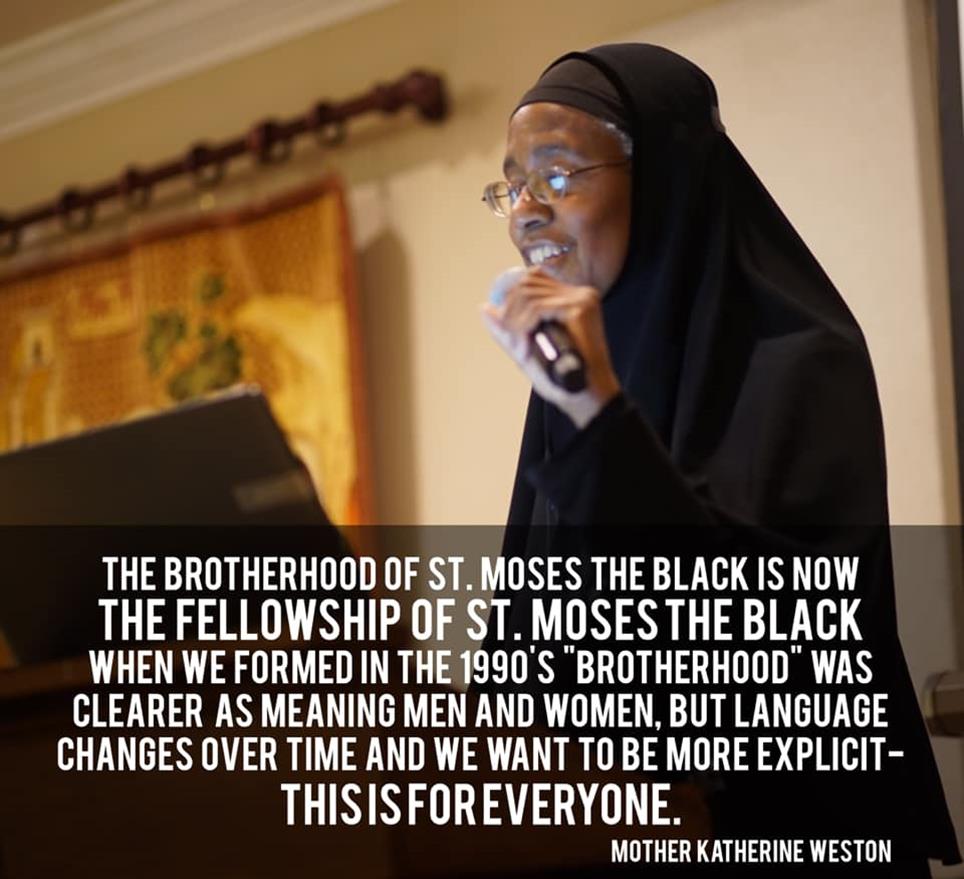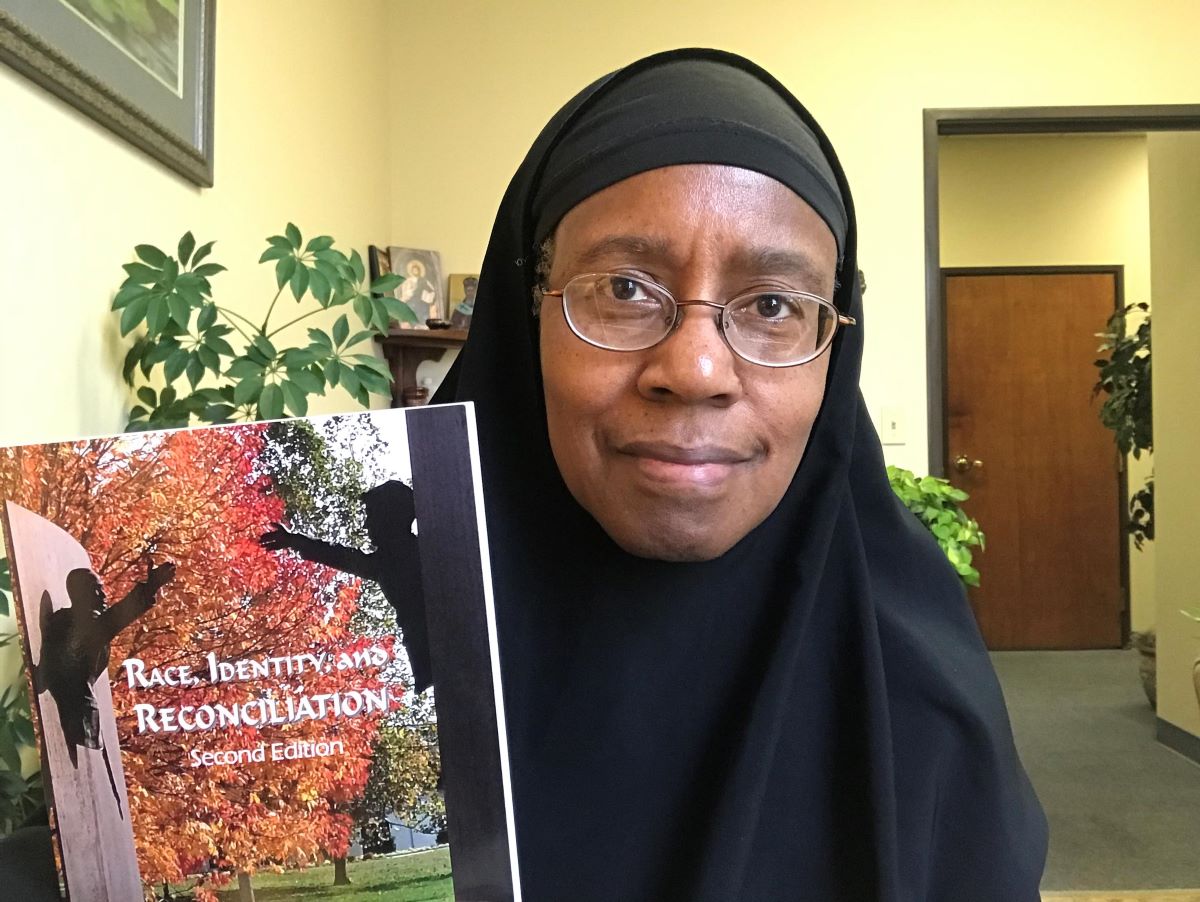Mother Katherine Weston is our Woman of the Week. She was nominated for her work in racial reconciliation, her leadership of her monastery and of the Fellowship of St. Moses the Black, her iconography and writing, and her work as a psychotherapist. You can see her here with with three reliquary icons she painted for the monastery, holding an icon she restored. We asked Mother Katherine how she came into the Church:
“This is how the saints and the icons drew me into the Holy Orthodox Church: I was raised in the historic St. Philip’s Episcopal Church in Harlem where my father was rector. St. Philip’s boasts a soaring neo-Gothic nave; the arches of the hammer-beam roof sit on carved corbels, each in the likeness of a different saint. One of them is St. Mary of Egypt, now my patron saint in Orthodox baptism. I credit her for praying me into the Faith.
“St. Nikolai Velimirović, the Serbian saint of great eloquence, toured parts of the U.S. in the 1920s. This was some 30 years before my father’s tenure at St. Philip’s, but the saint spoke to a crowd of 1500 African Americans there, receiving a standing ovation. I credit St. Nikolai, who loved the children of Harlem, for praying me into the Serbian Orthodox Church.
“I touched the hem of the garment of the Church during my first bout with grad school in the ’70s. A neighbor used Byzantine icons and chant during his devotions and the beauty of these touched me deeply. This encounter with otherworldly beauty acted as leaven in my creative endeavors, quietly bringing a lighter, more hopeful tone to my artwork.
“When my interest in the Orthodox Faith kindled a decade later, I began studying how to paint icons and also visiting monasteries. My catechism was from a seminary textbook on dogmatic theology, but in a sense I painted my way into the Church. Then my friends started asking me to teach them to paint. So I was baptized into the Faith and tonsured a nun in 1988; in 1989 I started teaching others what I knew of iconography to enhance their faith as well.
“When I came to the St. Xenia Monastic Community in Indianapolis in 1992, I brought iconography with me and have been painting and teaching here ever since, although in-person classes are now suspended. A handful of my students have gone on to study with master teachers and become competent in their own right, but most paint because it is a form of prayer that nourishes them as it has nourished me all these years.”
Axia!
Our Woman of the Week is Mother Katherine Weston, nominated for her many leadership roles in the Church. We asked Mother Katherine to tell us a little about how she came to be the head of the Fellowship of St. Moses the Black:
“The Fellowship of St. Moses the Black started in the early 1990s and I was one of the charter members. The Fellowship’s raison d’être is “to equip Orthodox Christians for the ministry of racial reconciliation and to share the Orthodox Christian faith with African Americans and people of color.” Our best-known activity is the annual conference where we have historically offered “Orthodoxy 101” presentations; talks about African saints and the prominent place of Africa in the development of the Early Church; presentations on the black experience in America; and a safe place to have interracial process groups.
“I have been a conference presenter and group facilitator from the beginning. Early on I began preparing my talks in booklet form for attendees and for Orthodox bookstores. But I always had the compilation of a book in the back of my mind. My pilot project was Loneliness or Fruitful Longing (2014) and I quickly recognized that the way to go was publishing “bite-sized” themed books rather than attempting one “complete” volume. Traditions of the Healing Church (2017) is an articulation of the Fellowship’s “Orthodoxy 101.” Race, Identity, and Reconciliation (2017) followed by, Illumining Shame, Anger, and Forgiveness (2018), curate themes from my many years of talks. Anxiety, Trust, and Gratitude is in the works.
“That publishing experience led me to chair the Fellowship’s book committee—we are currently developing the second and third volumes of the Unbroken Circle series—mostly curated from conference presentations. So you can see that I’ve been deeply involved in the education and reconciliation aspect of the Fellowship’s ministry from the beginning. The former president, Fr. Moses Berry, who brought us from the first conference to where we are today, nominated me to be his successor, and I stepped up from VP to that responsibility on Juneteenth* of this year. I see my role as one of helping to recognize what the Holy Spirit is raising up and to nurture and form that. With this year’s conference (October 9-10) being virtual, we have the opportunity to increase the scope of our ministry, shining Orthodoxy’s timeless light on the lived black experience to bring intelligibility to recent events.”
(*Juneteenth: a holiday celebrating the emancipation of enslaved people in the U.S. Lincoln’s Emancipation Proclamation was signed in January of 1863. However, it was not until Union troops reached Texas that the enslaved people in the farthest reaches of the Confederacy learned of their free status on June 19, 1865.)


As always, we asked Mother Katherine Weston, our Woman of the Week what the daily routine of the monastery looks like:
“At St. Xenia’s in Indianapolis, community time runs from 4:00 to 7:30 in the evening. We pray 9th Hour, Vespers, and Matins, following our prayers with a common meal and clean up. Sunday mornings of course we also have services and a meal. Beyond these focal points of the day, we each work, pray, and regroup according to our unique gifts and needs. That said, the rhythms of my life strongly affect the whole community.
“On Mondays I grocery shop. Tuesdays, Wednesdays, and Thursdays I see clients at my psychotherapy office. (I earned my counseling master’s and license while living here at St. Xenia’s with the help and support of the Sisters.) Now, of course, I see clients virtually, but I still go out to my office, a quiet refuge in gentle colors.
“Many clients are Orthodox. This, by the way, is how St. Xenia’s offers hospitality—by sparing me to spend time with people who, in a different context, might have come to visit a monastery with baskets of produce from their gardens, seeking to solve their life’s problems with an experienced monastic. This adaptation is how we make it work in our urban context.
“The rest of the days I am at home, working on monastery business, the behind-the-scenes counseling work and, of course, doing the work of the Fellowship of St. Moses the Black—with the other Sisters. They are the sounding boards of my every idea; they edit and proofread my publications.”
Thank you, Mother Katherine!
*If you are curious about the books that have been published by the monastery, you can learn more here:
Loneliness or Fruitful Longing (Transformative Wisdom Series, volume 1)
Race, Identity, and Reconciliation (Transformative Wisdom Series, volume 2)
Illumining Shame, Anger, and Forgiveness (Transformative Wisdom Series, volume 3)
Traditions of the Healing Church: Exploring the Orthodox Faith
Saint Nikolai Velimirovic, "The New Chrysostom": His Life and Service


